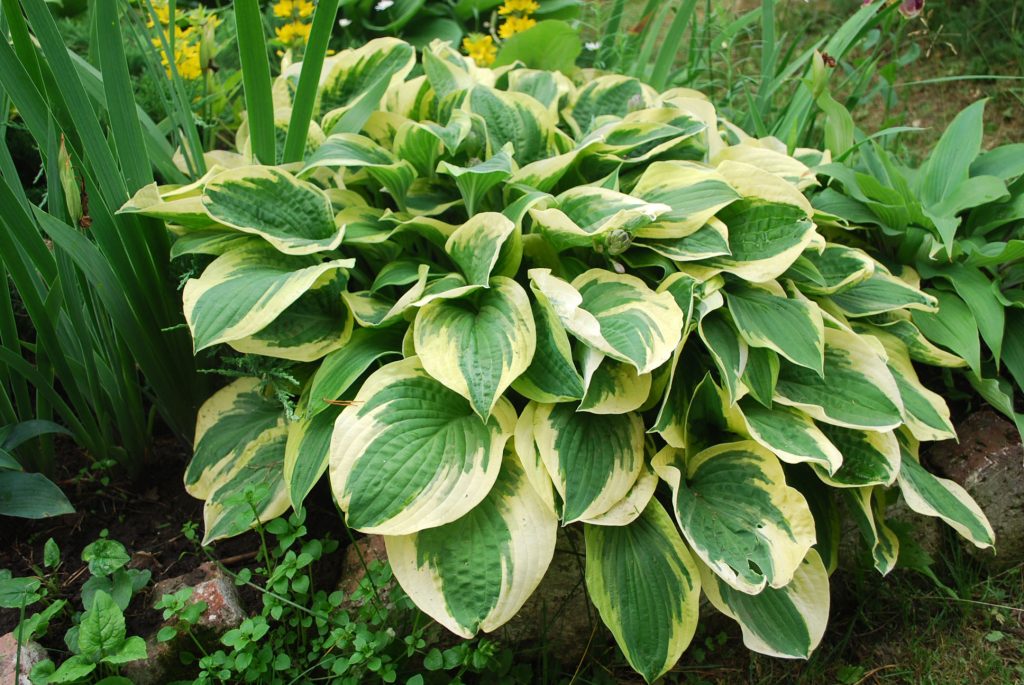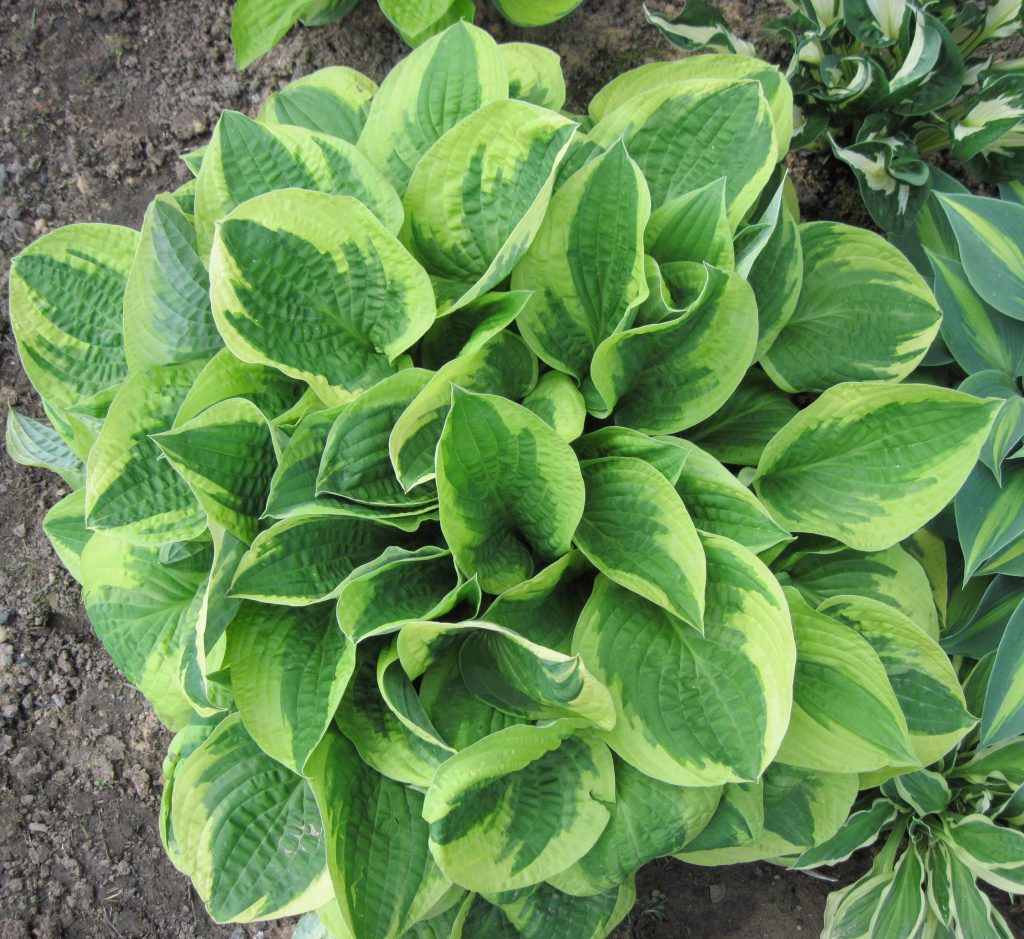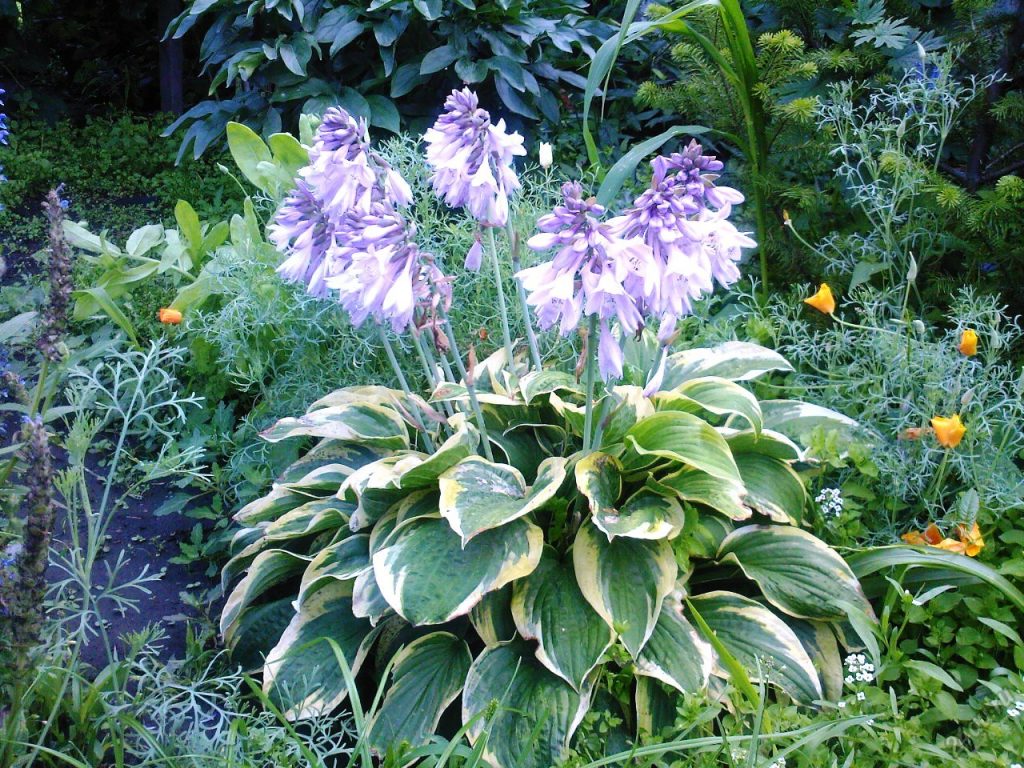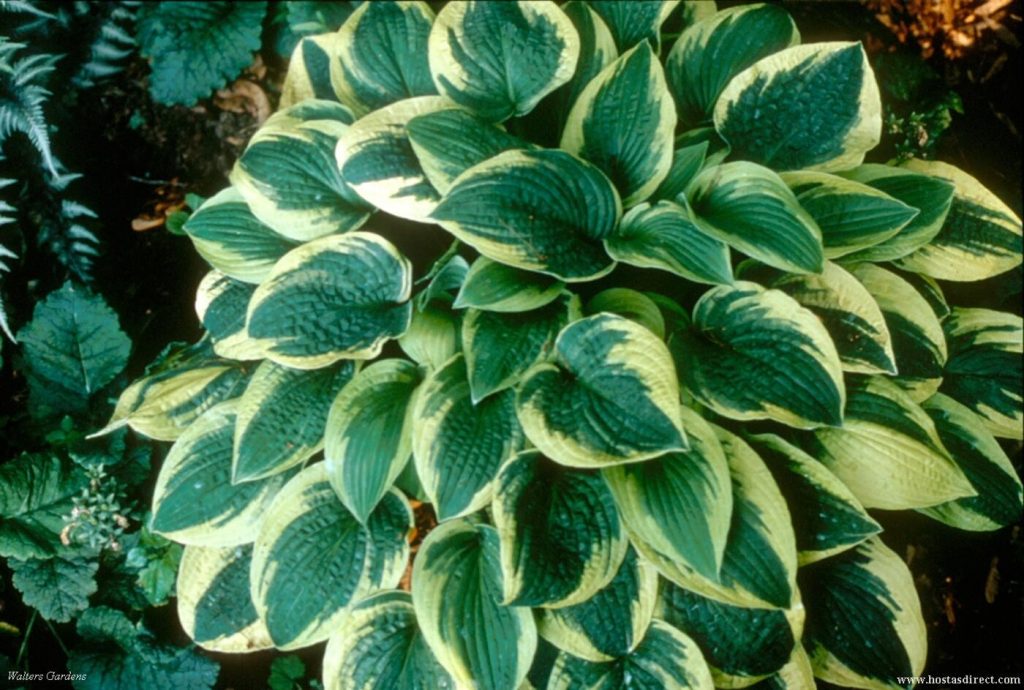Hosta Wide Brim - varietal features
Hosta Wide Brim is a popular ornamental perennial from the Asparagus family. The hybrid variety was obtained in 1979 by crossing the funky Bold One and Bold Ribbons (originator P. Aden). The name translated means "wide edge", illustrating the spectacular creamy border on the leaves.

Hosta wide brim description
Description of the variety
Wide Brim (or Wide Brim) is a medium-sized function, reaching a height of 40-50 cm. In diameter, the bush grows to 70-100 cm. The shape of the bush is domed, with beautifully flowing foliage. The leaves are juicy, dense, heart-shaped. The central part of the leaf is green, and the wide dashed edge is creamy (over time, the border brightens, but does not become completely white).
Wide Brim blooms in July and August, producing tall, non-leafy flower stalks. Lavender bell flowers are collected in rather lush (sometimes one-sided) inflorescences and have a pleasant aroma. This feature is characterized by a fast growth rate.
Landing features
Plants with an open root system are best planted in the spring, and container plants (with an earthen clod) - throughout the warm season. When buying hosts, pay attention to the quality of the product: whether there are spots on the leaves, dry roots, flabby leaves and softened stems. It is better to choose a place for planting in partial shade, so that diffused sunlight contributes to a beautiful variegation, but does not burn.

Hosta Wide Brim Description Photo
The function prefers soils with a neutral or slightly acidic reaction. On fertile soils, its decorative effect is revealed in all its glory, but a good effect can be achieved with the help of organic fertilizers. If moisture accumulates in the place designated for the hosts or groundwater is close to it, it is necessary to make an embankment and put high-quality drainage.
The distance from Wide Brim to the nearest perennials is at least 60 cm.
Technology:
- It is necessary to dig a hole 50-70 cm deep and wide.
- Drainage from small pebbles or broken bricks is laid at the bottom.
- The removed soil is mixed with compost or rotted manure. For seedlings with an earthen clod - fill a hole by a third, for funkia with open roots - make a slide in the center.
- The plant is placed in a hole, watered, covered with the remaining substrate.
- The hosts mulch the soil around them.
Care
The Wide Brim host is easy enough to grow: it is not capricious, it is resistant to pests and weather changes. The plant needs the most basic care - regular watering, several dressings, and seasonal pruning.
Mulching the soil helps to solve several problems at once: provide the function with nutrients, avoid weeding and loosening, reduce moisture evaporation, and protect the root system from overheating.
Watering
The function needs regular watering (2-3 times a week) - with sufficient moisture, its leaves grow large and bright. However, moist soil should not turn into a swamp and provoke fungal diseases.It is best to water the hosta in the morning, as the water attracts snails and slugs to the plant in the evening.
Top dressing
For excellent decorativeness and good growth of the funkii, three dressings per season are enough. In spring and autumn, the soil is mulched with dry organic matter and watered with two buckets of water. On the eve of flowering, water-soluble complexes of mineral fertilizers are applied.
Pruning and preparing for winter
At the end of flowering, dried peduncles are cut off. Yellowed leaves can be cut off in the fall, with the onset of the first cold weather, or in the spring, after wintering.

Hosta Wide Brim Photos
The function is a frost-resistant plant, but it does not hurt to cover it with dry fallen leaves for the winter.
Reproduction
The hybrid variety Wide Brim is not propagated by seeds, since the decorative characteristics are not preserved.
The division of the bush is carried out in the 5th year after planting, when the plant has time to fully develop and grow well.
The bush is dug up and divided into several parts (each must have at least one bud). Delenki are planted in the usual way in a semi-shaded place, mulched and watered regularly.
According to the description of gardeners, the function is successfully propagated by cuttings. Cuttings in the form of rosette shoots are cut "with a heel." To stimulate root formation, the sections are treated with Kornevin. The cuttings are deepened into well-loosened and moistened soil, covered with plastic bottles. Rooting takes place within 4-5 weeks.
Diseases and pests
Wide Brim rarely gets sick and is practically not affected by pests. Sometimes she is bothered by aphids - in such cases, the plant is washed with a solution of laundry soap. Dense leaves do not often attract slugs, snails and caterpillars, however, for prevention, the soil under the bush is sprinkled with ash, soda or tobacco. When watering, they try not to fall on the leaves, directing the stream strictly to the root.
Fungal diseases and the X virus, which exclusively affects hosts, pose a potential risk to the function. In the first case, the bush can be saved by cutting off the affected parts, treating it with a fungicide and replanting it to a new place in healthy soil, in the second, the treatment is useless (the plant must be dug up and burned). Proper care, disinfection of equipment and drainage, and a thorough examination of the seedlings when purchasing will help to avoid diseases.
Use in landscape design
The Wide Brim function has long and successfully been used in the landscape design of gardens, summer cottages, parks. It looks spectacular next to stones and ponds, in flower beds, in mixborders and rock gardens.

Host wide brim photo
A lush bush can play the role of a tapeworm, complement a multi-tiered composition, serve as a frame for individual zones or as a living border.
Like many other hosts, Wide Brim is in perfect harmony with conifers (thujas, junipers, small pines and spruces). It looks beautiful with fern, decorative cereals, astilba, geyhera. In flower beds, it is planted next to roses, irises, delphinium, lilies, forget-me-nots, peonies.
Testimonials
The Wide brim host is included in the list of the most hassle-free and grateful garden plants. It requires minimal maintenance, but it grows well, pleasing the eye with lush rosettes and beautiful variegation. Some growers use original leaves to create bouquets and flower arrangements.
Judging by the descriptions, this function blooms nicely: the lavender inflorescences of bells do not look inconspicuous, like in many other varieties. However, not all gardeners consider flowering to be decorative. To preserve the domed shape of the bush, they break off the peduncles in advance.

